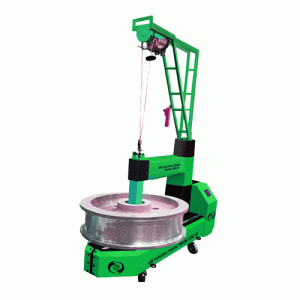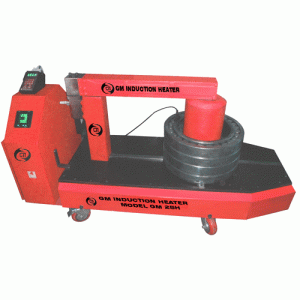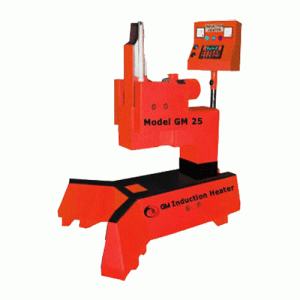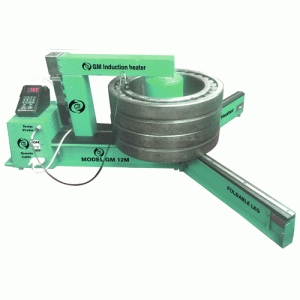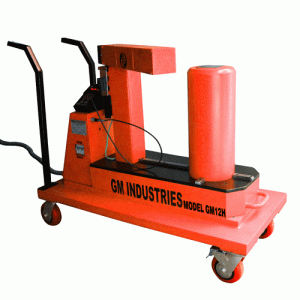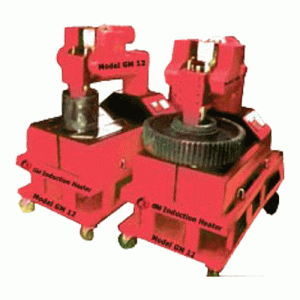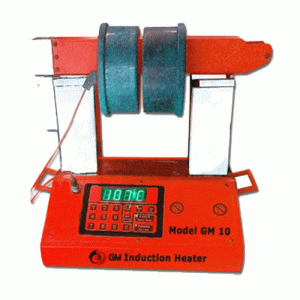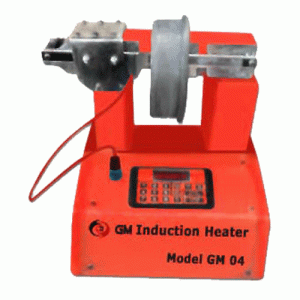Induction Brazing
What is Brazing?
Brazing is a metal-joining process in which a filler metal melts at a higher temperature than the metals being joined. The filler metal, also known as brazing alloy or braze, is heated to melting temperature and then distributed between the two metal pieces being joined. Brazing typically entails heating the metals being joined to a temperature lower than the melting point of the base metals but higher than the melting point of the filler metal. When the filler metal solidifies, it flows between the pieces of metal being joined, forming a strong and permanent bond.
Brazing is widely used in the production of a variety of products, including plumbing fixtures, automotive parts, and aerospace components. It is also used in metal part repair because it allows for the joining of different metals and can often be done without the need for additional machining or finishing.
The most common method used for brazing is torch brazing, which involves using a flame torch to heat the metals being joined and the brazing alloy. This method is relatively simple and inexpensive, making it a popular choice for small-scale brazing operations. However, induction heating has become increasingly popular for brazing in recent years due to its numerous advantages. Induction heating uses an electromagnetic field to heat the metals being joined and the brazing alloy, rather than a direct flame, which offers several benefits.
Why is the Induction Heater used for Brazing Processes?
Induction heaters are commonly used for brazing processes due to their numerous advantages over other heating methods. One of the main benefits of using an induction heater is its efficiency. Unlike other heating methods, induction heating is highly efficient because it only heats the area where the brazing alloy is needed, resulting in reduced energy consumption and a shorter overall brazing process. Another advantage of induction heating is its precise temperature control. The temperature of the workpiece and the brazing alloy can be accurately controlled using induction heating, which ensures that the brazing alloy is melted and distributed evenly. This results in stronger and more reliable bonds between the metals being joined. Additionally, induction heating is a cleaner process compared to other heating methods such as torch brazing. Torch brazing can produce smoke and fumes, while induction heating does not. This makes induction heating a safer and more environmentally friendly option. Overall, the efficiency, precise temperature control, and cleanliness of induction heating make it a popular choice for brazing processes in a variety of industries.
Introduction to Industrial Induction Heater for Brazing
Brazing is a metal-joining process that involves heating two or more metal components to a temperature above their melting point, but below the melting point of the base metal, and then adding a filler metal or brazing alloy. The brazing alloy is melted and flows into the joint by capillary action, creating a strong bond between the two metal components. Industrial induction heaters are widely used for brazing applications in various industries due to their numerous advantages over other heating methods. Induction heating is a non-contact heating method that uses an alternating magnetic field to generate heat within the workpiece, which melts the brazing alloy and creates a strong bond between the two metals being joined. GM Industries is a leading supplier of industrial induction heaters for brazing applications. They offer a wide range of induction heating equipment that is designed to meet the specific needs of each customer. GM Industries’ team of experienced engineers work closely with their clients to understand their brazing requirements and recommend the most suitable induction heating solution.
Advantages of Using an Industrial Induction Heater for Brazing
Using an industrial induction heater for brazing offers several advantages over other heating methods. Here are some of the main advantages:
Speed and Efficiency
Induction heating only heats the area where the brazing alloy is needed, resulting in reduced energy consumption and shorter heating times. This makes induction heating a faster and more cost-effective option compared to other heating methods such as torch brazing.
Precise Temperature Control
Industrial induction heaters offer precise temperature control, ensuring that the brazing alloy is melted and distributed evenly. This results in stronger and more reliable bonds between the metals being joined.
Clean and Safe Operation
Induction heating does not produce smoke or fumes, making it a more environmentally friendly option. It also offers a safer and cleaner heating process compared to other methods such as torch brazing.
Versatility
Industrial induction heaters can be customized to suit a variety of brazing applications, from small-scale production to high-volume manufacturing. They can be used to braze a wide range of metals and alloys, including copper, brass, aluminium, stainless steel, and titanium.
Cost-Effective
Industrial induction heaters have a long lifespan and require minimal maintenance, making them a cost-effective option in the long run.
Overall, the speed, efficiency, precise temperature control, cleanliness, versatility, and cost-effectiveness of industrial induction heaters make them a popular choice for brazing applications in a variety of industries.
Induction Heater for Various Brazing Process

Induction Pump
Pumps are critical components in many industrial and commercial applications. Induction brazing is often used to join the various components of pumps, including impellers, casings, and shafts. Induction heating allows for precise temperature control, ensuring that the brazing alloy melts evenly and forms a strong bond between the components. Using an industrial induction heater for brazing pumps also ensures a clean and safe brazing process.

Induction heater for brazing valves
Valves are essential components in many industrial and commercial applications. Brazing is often used to join the various components of valves, including bodies, discs, and stems. Induction heating provides precise temperature control, ensuring that the brazing alloy melts evenly and forms a strong bond between the components. Using an industrial induction heater for brazing valves ensures a fast, efficient, and clean brazing process.

Induction Transformers
Transformers are critical components in many electrical systems. Induction brazing is often used to join the various components of transformers, including the core, windings, and terminals. Induction heating provides precise temperature control, ensuring that the brazing alloy melts evenly and forms a strong bond between the components. Using an industrial induction heater for brazing transformers ensures a fast, efficient, and reliable brazing process.

Induction heater for brazing pressure vessels
Pressure vessels are used in many industrial applications, including chemical processing and power generation. Brazing is often used to join the various components of pressure vessels, including shells, nozzles, and flanges. Induction heating provides precise temperature control, ensuring that the brazing alloy melts evenly and forms a strong bond between the components. Using an industrial induction heater for brazing pressure vessels ensures a safe, efficient, and reliable brazing process.

Induction heater for brazing radiator tubes
Radiators are used in many industrial and commercial applications, including HVAC systems and power generation. Brazing is often used to join the various components of radiator tubes, including fins, headers, and tubes. Induction heating provides precise temperature control, ensuring that the brazing alloy melts evenly and forms a strong bond between the components. Using an industrial induction heater for brazing radiator tubes ensures a fast, efficient, and reliable brazing process.

Induction heater for brazing brake tubing
Brake tubing is used in many industrial and automotive applications. Brazing is often used to join the various components of brake tubing, including fittings and tubing. Induction heating provides precise temperature control, ensuring that the brazing alloy melts evenly and forms a strong bond between the components. Using an industrial induction heater for brazing brake tubing ensures a fast, efficient, and reliable brazing process.

Induction heater for brazing exhaust systems
Exhaust systems are critical components in automotive and industrial applications. Brazing is often used to join the various components of exhaust systems, including pipes, mufflers, and catalytic converters. Induction heating provides precise temperature control, ensuring that the brazing alloy melts evenly and forms a strong bond between the components. Using an industrial induction heater for brazing exhaust systems ensures a fast, efficient, and reliable brazing process.

Induction heater for brazing fuel lines
Fuel lines are used in many industrial and automotive applications. Brazing is often used to join the various components of fuel lines, including fittings and tubing. Induction heating provides precise temperature control, ensuring that the brazing alloy melts evenly and forms a strong bond between the components. Using an industrial induction heater for brazing fuel lines ensures a fast, efficient, and reliable brazing process.

Induction Heater for Brazing Hydraulic Lines
Brazing is a common method of joining hydraulic lines in various industrial applications. Induction heating is an effective way to heat hydraulic lines quickly and uniformly. The process involves placing the hydraulic line within an induction coil, which creates an electromagnetic field that heats the workpiece. The high-frequency current generates heat through the resistance of the metal, causing it to melt and fuse together. This method of brazing hydraulic lines is important because it ensures a strong, leak-free joint.

Induction Heater for Brazing Electronic Connectors
Induction heating is a popular method for brazing electronic connectors, as it offers a high level of control over the heating process. By using an induction heater, the temperature of the workpiece can be precisely controlled to ensure that the brazing material melts at the right temperature. The process involves placing the electronic connector within an induction coil, which generates an electromagnetic field that heats the workpiece. The high-frequency current causes the metal to melt and fuse together, creating a strong, reliable joint. This method of brazing electronic connectors is important because it ensures that the joint is reliable and long-lasting.

Motor Induction
Induction heating is often used in the assembly of electric motors. The process involves heating the various components of the motor to a specific temperature, allowing them to be assembled and brazed together. By using an induction heater, the temperature can be precisely controlled, which is important for ensuring the proper brazing temperature is reached. The induction coil is placed around the motor component, and the high-frequency current heats the metal, causing it to melt and fuse together. This method of brazing motors is important because it ensures a strong, reliable joint, which is critical for the performance and longevity of the motor.

Generator Induction
Induction heating is commonly used in the assembly of generators. The process involves heating the various components of the generator to a specific temperature, allowing them to be assembled and brazed together. By using an induction heater, the temperature can be precisely controlled, which is important for ensuring the proper brazing temperature is reached. The induction coil is placed around the generator component, and the high-frequency current heats the metal, causing it to melt and fuse together. This method of brazing generators is important because it ensures a strong, reliable joint, which is critical for the performance and longevity of the generator.

Induction Heater for Brazing Heat Exchangers
Induction heating is a popular method for brazing heat exchangers, as it offers a high level of control over the heating process. By using an induction heater, the temperature of the workpiece can be precisely controlled to ensure that the brazing material melts at the right temperature. The process involves placing the heat exchanger within an induction coil, which generates an electromagnetic field that heats the workpiece. The high-frequency current causes the metal to melt and fuse together, creating a strong, reliable joint. This method of brazing heat exchangers is important because it ensures that the joint is reliable and long-lasting.

Induction Heater for Brazing Refrigeration Tubing
Brazing is a common method of joining refrigeration tubing in various industrial applications. Induction heating is an effective way to heat refrigeration tubing quickly and uniformly. The process involves placing the tubing within an induction coil, which creates an electromagnetic field that heats the workpiece. The high-frequency current generates heat through the resistance of the metal, causing it to melt and fuse together. This method of brazing refrigeration tubing is important because it ensures a strong, leak-free joint.

Induction Pipe Heater
An induction heater is a powerful and efficient tool for brazing pipes. It is used in various applications such as plumbing, HVAC systems, and automotive industries. The process of brazing pipes involves heating the joint area to a specific temperature and melting the brazing filler metal, which flows into the joint and creates a strong bond. Induction heating can provide precise, localized heating to the joint area, which reduces the risk of overheating the surrounding pipe and other components. The use of an induction heater for brazing pipe results in faster and cleaner joints, higher productivity, and lower energy costs.

Induction Heater for Brazing Bus Bars
Bus bars are essential components in many electrical systems, and their proper installation is crucial to ensure safe and reliable operation. Brazing is a common method used to join bus bars together, and an induction heater is an excellent tool for this purpose. The process involves heating the joint area to a specific temperature and melting the brazing filler metal, which flows into the joint and creates a strong bond. Induction heating can provide fast and uniform heating to the joint area, resulting in a consistent and high-quality bond. The use of an induction heater for brazing bus bars results in reduced processing time, improved bond strength, and reduced material waste.

Induction Heater for Brazing Heat Sink
Heat sinks are essential components used to dissipate heat from electronic devices and prevent overheating. They are typically made of aluminium, which requires brazing to attach it to other components. An induction heater is an ideal tool for brazing heat sinks due to its precise and localized heating. The process involves heating the joint area to a specific temperature and melting the brazing filler metal, which flows into the joint and creates a strong bond. Induction heating can provide fast, uniform heating to the joint area, which reduces the risk of overheating and damaging other components. The use of an induction heater for brazing heat sinks results in improved joint quality, reduced processing time, and increased productivity.
Induction Heaters Offered by GM Industries
For more information on any of our high quality products or getting accurate prices contact GM Industries at
Call Us
+(91)-9820533489 / 7738562224
Enquiry Form
Submit
Frequently Asked Questions
An induction heater is used to generate heat in a localized area, allowing for precise and efficient brazing of metals.
An induction heater can be used to braze a variety of metals including steel, aluminium, copper, brass, and bronze.
An induction heater uses electromagnetic induction to generate heat in a conductive material, which is then used to melt the brazing material and join the two metal pieces together.
Yes, an induction heater can be used for both small and large-scale brazing applications.
Yes, flux is necessary when brazing with an induction heater to help clean the surfaces of the metals being brazed and to help prevent oxidation.
The time it takes to heat metals for brazing using an induction heater varies depending on the size and type of metal being brazed, but typically ranges from a few seconds to a few minutes.
Safety precautions when using an induction heater for brazing include wearing protective gear such as gloves and eye protection, ensuring proper ventilation, and following manufacturer guidelines.
Can an induction heater be used in a vacuum for brazing?
Yes, induction heaters can be used for annealing large metal components such as tanks and shafts.
No, induction heaters are specifically designed for annealing metal components.
Induction heaters are highly energy-efficient, using up to 90% less energy compared to other heating methods.
Yes, induction heaters can be used for continuous annealing processes in industries such as automotive and aerospace.
Yes, an induction heater can be used for brazing in hard-to-reach areas since it provides a precise and focused source of heat.
The power output of an induction heater affects the brazing process by determining the amount of heat generated and the speed at which the metal is heated.
Maintenance for an induction heater used in brazing includes regular cleaning and inspection, checking for worn or damaged parts, and ensuring proper electrical connections.
Yes, an induction heater can be used for brazing of dissimilar metals by using a suitable brazing alloy and flux.
Temperature monitoring is important during brazing using an induction heater to ensure that the metal is heated to the correct temperature for the brazing process.
Yes, an induction heater can be used for brazing of fragile or delicate parts since it provides a focused and precise source of heat.
Preheating metal before brazing with an induction heater is not always necessary, but may be required for certain applications and metals.
No, an induction heater cannot be used for brazing of non-metals since it relies on electromagnetic induction to generate heat in conductive materials.
The temperature control on an induction heater is highly accurate, often within a few degrees of the desired temperature. This allows for precise control over the brazing process.



